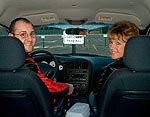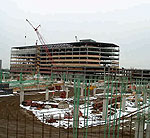By Andrew Haeg
Minnesota Public Radio
April 8, 2002
By one estimate, congestion is rising in the Twin Cities faster than in any other city than Atlanta. Nowhere is rising congestion a bigger problem than along I-494, part of the beltway that runs around the Twin Cities. The portion of 494 that runs from Bloomington to Eden Prairie has proven an immensely attractive location for businesses. But 494's allure is also a problem. The continuing influx of new workers may soon bring traffic there to a halt.
| |
|
|
|
||
At 6 a.m., and Scott Grossmann leaves his house in Oakdale, a suburb east of St. Paul, to drive to his job at Best Buy in Eden Prairie, a Minneapolis suburb. He usually gets there by 7.
Unlike most commuters, Scott isn't driving alone. He runs a van pool. He's on his way to pick up two other riders, Cindy Anderson and Pam Pettee, also employees of Best Buy.
Cindy Anderson chose to take the vanpool after nine-and-a-half years of commuting daily from Woodbury, 28 miles in each direction. She says the stress was too much, and she could no longer beat the traffic.
"It used to be the earlier hours were no problem. But now the time has just pushed back and back, so you almost have to leave by 6 to have a smooth commute; it's really gotten terrible," according to Anderson.
At close to 7 a.m., the van pool travels west on 494 past Lyndale Avenue.
"Right now,it's starting to pick up and it's 6:45," notes Pam Pettee. "In another 10, 15 minutes it'll just be stop- and-go from here all the way to work. So congestion is a big concern."
| |
|
|
|
||
The van passes a construction site. Cranes tower over several massive structures, which are now just skeletons of steel girders. It's Best Buy's new headquarters. By next year, 5,500 people will work there. The new parking ramp will be able to hold 7,500 cars.
Pam expects her commute to the new headquarters will be shorter than it is now, but the influx of Best Buy workers to the 494 corridor may lead to longer commutes for everyone else.
Like other ring roads throughout America, the federal government helped build 494 in the 1950s for returning war veterans settling in the suburbs. Businesses soon found the southern 494 corridor - from Bloomington to Eden Prairie - an ideal location. The corridor is roughly equidistant to St. Paul and Minneapolis, and the airport is nearby.
"I-494, especially between 169 and the airport, as an east-west artery it's connected well by 35W, by 169 by Highway 100, even to a certain extent France Avenue, and to a greater extent, Cedar Avenue. And those accesses make it a desirable location," says John Donnelly, a property developer for the Frauenshuh Companies in Edina.
Today, almost as many people work along the 494 corridor as do in Minneapolis, and within the next 20 years, twice as many people will be working along the corridor. That will be more than all the jobs currently in Minneapolis and St. Paul combined.
But with prosperity comes congestion. At rush hour, traffic moves at a glacial pace.
"We're working on a roadway that was built in the mid-50s. It was OK through the '60s and most of '70s, but then we started running into difficulties. And nothing has been done about it," according to Jim Hovland, is chair of the 494 Corridor Coalition, a group of businesses and government officials from the five cities along the 494 corridor.
| |
|
|
|
||
To him, 494's problems are clear, and intractable: Traffic along the southern portion of 494 has tripled since 1976, but the southern corridor is still only three lanes wide in most places.
"I think that they've probably got a greater number of surface lanes around Fargo Moorhead than they do around Minneapolis-St. Paul in terms of the number of lanes that we have on 494," Hovland suggests.
Many businesses still feel the 494 corridor's assets outweigh its traffic problems. But John Donnelly, the property developer with Frauenshuh Companies, says that's changing. "There have been several companies that have reconsidered the 494 corridor as a location and have moved to areas that are either more easily accessible or have highway infrastructure that is more modern," Donnely says.
Rising congestion didn't stop Best Buy from building its new, 1.5 million square foot corporate campus at the intersection of 494 and Penn Avenue.
Best Buy's choice of sites spurred controversy. Local residents and others felt thousands of new Best Buy workers would make congestion worse. Best Buy went ahead despite the protests. The company argued that the site is central to its employees, many of whom live in the southern suburbs.
As part of its decision to build along 494, Best Buy pledged to make its new campus accessible to buses, and it agreed to encourage employees to consider alternative ways to get to work.
Leading that effort is Sally Carlson Bancroft, Best Buy's transportation coordinator. "We're going to continue to have a lot of people traveling large distances to work. We have to give them options and encourage them to choose those options," she said.
She says a company poll showed at least 25 percent of employees would consider alternatives to driving alone in their car. Those include car pools, buses and van pools. Those who are choosing other options, like the van pool passengers, say they don't mind giving up some freedom for a cheaper, less stressful commute.
The van pool costs each passenger $70 a month. Best Buy pays $50 of that, and recently the Golden Triangle Transportation Management Association has kicked in the other $20.
But passenger Cindy Anderson says vanpools aren't catching on because people have to go out of their way to use them. "There's no convenient spots on our commute, like say there's some of those of those express pickups; that'd be nice, we don't have any of those to offer. That's really what it's all about, the convenience. I think if they'd make it more convenient, people could justify doing it," she says.
Convenient van pools are just one of many solutions politicians and business leaders say they need to avoid gridlock along the 494 corridor.
The most obvious solution is to add more lanes, but that's very expensive. So, Phil Rivness, a Met Council representative for the 5th district, which contains part of the 494 corridor, says building roads is only one of several solutions.
"It's been forecasted recently that in the next 30 years, we're going to add 930,000 people to our metropolitan area. A fair amount of it will be in the southwest quadrant, and a lot of jobs will continue to be sited there. So we need to do all of these things. We need to enhance transit, we need to look as creatively as we can on options to using single occupancy cars. If we don't do all three? We're going to have gridlock," Rivness says.
To pay for all of this, Rivness says the state should consider raising the gas tax or dedicating a sales tax to transportation projects.
Estimates are that it'll cost between $400 and $500 million to upgrade 494 so it can handle the rising traffic. That includes adding a lane in each direction, and rebuilding old stretches of pavement.
Currently, the state has dedicated no money to do any of those things.



